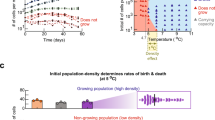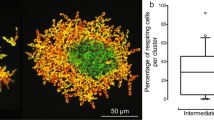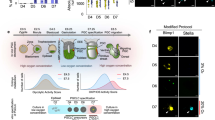Abstract
THE pioneering studies of Hayflick1 showed that normal human diploid cells of the WI-38 strain have a limited lifespan of approximately 50±10 population doublings (PDL) in vitro. It is still not known to what extent this phenomenon is the result of the artificiality of the cell culture system : factors such as nutrition and ambient environmental factors may restrict the ability of these cells to express their true genetic potential. To what extent genetic and environmental factors act to constrain the lifespan of human diploid cells in culture is open to experiment. In the present study we have evaluated one important ambient factor of the environment, the oxygen concentration, on the growth and lifespan of two human diploid cell strains, WI-38 and IMR-90. Our results show that growth at oxygen concentrations less than 20% is enhanced and that an extension of about 25% of the lifespan of both cell types was realised by long term cultivation under 10% oxygen. This indicates that the potential for long term growth in culture of normal diploid cells may be appreciably enhanced by more exact control of environmental factors.
This is a preview of subscription content, access via your institution
Access options
Subscribe to this journal
Receive 51 print issues and online access
$199.00 per year
only $3.90 per issue
Buy this article
- Purchase on Springer Link
- Instant access to full article PDF
Prices may be subject to local taxes which are calculated during checkout
Similar content being viewed by others
References
Hayflick, L. Expl Cell Res. 37, 614–636 (1965).
Nolan, J. S. & Packer, L. Methods in Enzymology XXXII(B) (eds Fleischer, S., Packer, L. & Estabrook, R. W.) 561–568 (Academic, New York, 1974).
Packer, L. & Smith, J. R. Proc. natn. Acad. Sci. U.S.A. 71, 4763–4767 (1974).
Taylor, W. G., Richter, A., Evans, V. J. & Sanford, K. K. Expl Cell Res. 86, 152–156 (1974).
Richter, A., Sanford, K. K. & Evans, V. J. J. natn. Cancer Inst. 49, 1705–1711 (1972).
Balin, A. K., Goodman, D. B. P., Rasmussen, H. & Cristofalo, V. J. J. Cell Physiol. 89, 235–249 (1976); J. Cell Biol. (in the press).
Packer, L. Aging, Carcinogenesis and Radiation Biology (ed. Smith, K. E.) 519–535 (Plenum, New York, 1976).
Packer, L. & Smith, J. R. Proc. natn. Acad. Sci. U.S.A. (in the press).
Author information
Authors and Affiliations
Rights and permissions
About this article
Cite this article
PACKER, L., FUEHR, K. Low oxygen concentration extends the lifespan of cultured human diploid cells. Nature 267, 423–425 (1977). https://doi.org/10.1038/267423a0
Received:
Accepted:
Issue Date:
DOI: https://doi.org/10.1038/267423a0
This article is cited by
-
In situ monitoring reveals cellular environmental instabilities in human pluripotent stem cell culture
Communications Biology (2022)
-
Cell division drives DNA methylation loss in late-replicating domains in primary human cells
Nature Communications (2022)
-
A prevalent neglect of environmental control in mammalian cell culture calls for best practices
Nature Biomedical Engineering (2021)
-
Ultrafine silicon dioxide nanoparticles cause lung epithelial cells apoptosis via oxidative stress-activated PI3K/Akt-mediated mitochondria- and endoplasmic reticulum stress-dependent signaling pathways
Scientific Reports (2020)
-
Tissue-infiltrating macrophages mediate an exosome-based metabolic reprogramming upon DNA damage
Nature Communications (2020)
Comments
By submitting a comment you agree to abide by our Terms and Community Guidelines. If you find something abusive or that does not comply with our terms or guidelines please flag it as inappropriate.



